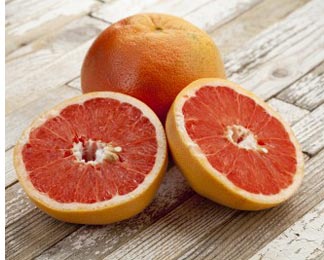POW! Right in the Kisser
- By Chris Mittelstaedt
- Reading Time: 2 mins.
 Grapefruit will not be ignored. If you dig into one, you are just as likely to get a clownish squirt in the eye as to have your other senses treated to a trumpeter’s storm of fragrance and color. The aroma of grapefruit can hit high notes Maynard Ferguson can’t reach. It has the juiciness of Miles Davis’ “round sound” and comes in an array of yellows, pinks, and reds to light Dizzy Gillespie’s “Night in Tunisia.”
Grapefruit will not be ignored. If you dig into one, you are just as likely to get a clownish squirt in the eye as to have your other senses treated to a trumpeter’s storm of fragrance and color. The aroma of grapefruit can hit high notes Maynard Ferguson can’t reach. It has the juiciness of Miles Davis’ “round sound” and comes in an array of yellows, pinks, and reds to light Dizzy Gillespie’s “Night in Tunisia.”
Its origins can be traced to Asia, but grapefruit’s hybridization and blossoming belong to the Caribbean. Originally, grapefruit was most likely a naturally occurring hybrid between the pomelo and the sweet orange. The red grapefruit variety found a home and thrived in Texas and has consequently partnered to the Rio Grande Valley. Reds are found under names like Rio Red and Star Ruby. Other varieties include pink, Thompson, Marsh, and Duncan, the latter of which range from yellow to pale yellow and fall into the “white” grapefruit category. Since it tastes nothing like grapes, it is thought that grapefruit’s moniker comes from how it grows in grape-like clusters on the tree.
Want fruit for your office?
Get your office a free sample TODAY! Nutritionally, grapefruit toots its own horn. Pink and red grapefruit contain the beneficial antioxidant lycopene, and all grapefruit is high in vitamin C and fiber. It has other properties that aid in joint health. Even the extract from its seeds is a powerful antiseptic. However, be aware that grapefruit contains a compound that can interfere with the absorption of some statin-based medications.
Nutritionally, grapefruit toots its own horn. Pink and red grapefruit contain the beneficial antioxidant lycopene, and all grapefruit is high in vitamin C and fiber. It has other properties that aid in joint health. Even the extract from its seeds is a powerful antiseptic. However, be aware that grapefruit contains a compound that can interfere with the absorption of some statin-based medications.
Enjoy & Be Fruitful! chiefbanana@fruitguys.com


